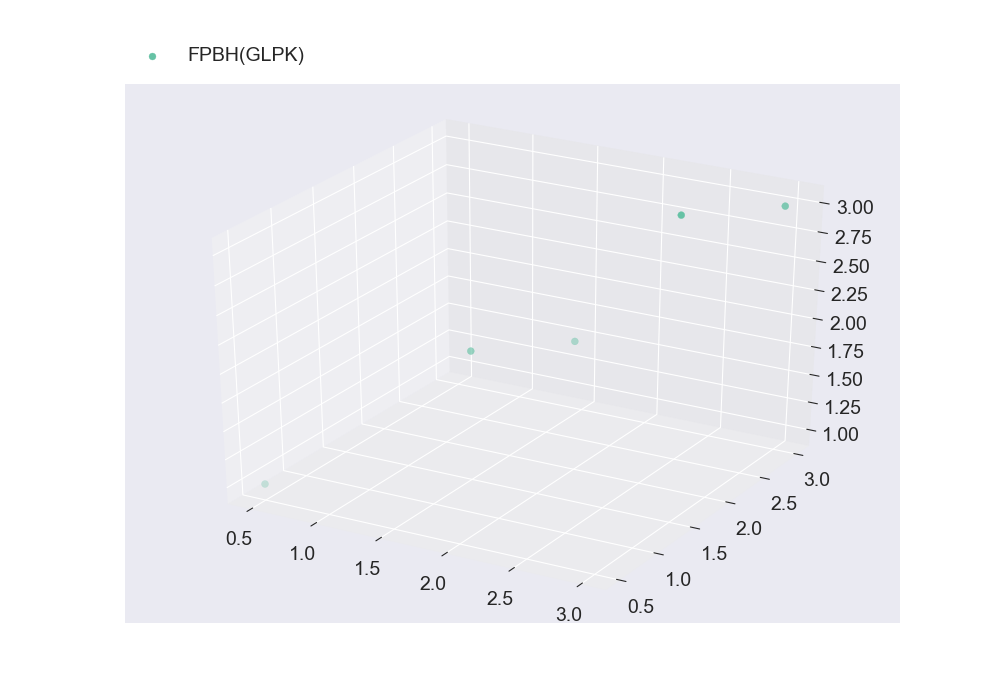Getting Started
using Modof, JuMP, FPBH, GLPKMathProgInterface, ClpWarm Up FPBH:
FPBH.jl has four implementations, one each for biobjective pure binary, biobjective mixed binary, multiobjective pure binary and multiobjective mixed binary program. Thus, it is recommended that before fpbh is used for any actual instance, warmup_fpbh is used to compile all of the four implementations.
Using Clp as the underlying LP Solver to warm up FPBH
warmup_fpbh(lp_solver=ClpSolver(), threads=1)Using JuMP Extension:
Providing the following multi-objective mixed integer linear program as a ModoModel:
model = ModoModel()
@variable(model, x[1:2], Bin)
@variable(model, y[1:2] >= 0.0)
objective!(model, 1, :Min, x[1] + x[2] + y[1] + y[2])
objective!(model, 2, :Max, x[1] + x[2] + y[1] + y[2])
objective!(model, 3, :Min, x[1] + 2x[2] + y[1] + 2y[2])
@constraint(model, x[1] + x[2] <= 1)
@constraint(model, y[1] + 2y[2] >= 1)Note: Currently constant terms in the objective functions are not supported
Using GLPK as the underlying LP Solver, and imposing a maximum timelimit of 10.0 seconds
@time solutions = fpbh(model, timelimit=10.0)Writing nondominated frontier to a file
write_nondominated_frontier(solutions, "nondominated_frontier.txt")Writing nondominated solutions to a file
write_nondominated_sols(solutions, "nondominated_solutions.txt")Nondominated frontier
nondominated_frontier = wrap_sols_into_array(solutions)Hypervolume of the nondominated frontier
For this functionality, pyModofSup.jl must be properly installed.
using pyModofSupcompute_hypervolume_of_a_discrete_frontier can be used for computing the hypervolume of a nondominated frontier, however all the objectives must be minimizations.
nondominated_frontier[:, 2] = -1.0*nondominated_frontier[:, 2] # Converting the second objective function values into minimization
compute_hypervolume_of_a_discrete_frontier(nondominated_frontier)Plotting the nondominated frontier
For this functionality, pyModofSup.jl must be properly installed.
using pyModofSupIt is important to note that the plotting functions only work through IJulia. For just viewing the nondominated frontier, one can use the following instructions in an IJulia cell:
nondominated_frontier = wrap_sols_into_array(solutions)
plt_discrete_non_dom_frntr([nondominated_frontier], ["FPBH(GLPK)"])
However, if the user desires to save the plot of the nondominated frontier to a file ("Plot1.png" in this case), they can use the following instructions in a julia terminal:
nondominated_frontier = wrap_sols_into_array(solutions)
plt_discrete_non_dom_frntr([nondominated_frontier], ["FPBH(GLPK)"], false, "Plot1.png")Using CLP instead of GLPK as the underlying LP Solver, and imposing a maximum timelimit of 10.0 seconds
@time solutions = fpbh(model, lp_solver=ClpSolver(), timelimit=10.0)Using LP File Format
Providing the following multiobjective mixed integer linear program as a LP file:
Format:
The first objective function should follow the convention of LP format of single objective optimization problem
The other objective functions should be added as constraints with RHS = 0, at the end of the constraint matrix in the respective order
Variables and constraints should also follow the convention of LP format of single objective optimization problem
write("Test.lp", "\\ENCODING=ISO-8859-1
\\Problem name: TestLPFormat
Minimize
obj: x1 + x2 + x3 + x4
Subject To
c1: x1 + x2 <= 1
c2: x3 + 2 x4 >= 1
c3: x1 + x2 + x3 + x4 = 0
c4: x1 + 2 x2 + x3 + 2 x4 = 0
Binaries
x1 x2
End\n") # Writing the LP file of the above multiobjective mixed integer program to Test.lpUsing GLPK as the underlying LP Solver, and imposing a maximum timelimit of 10.0 seconds
The sense of the first objective function is automatically detected from the LP file, however the senses of the rest of the objective functions should be provided in the proper order.
@time solutions = fpbh("Test.lp", [:Max, :Min], timelimit=10.0)Using CLP instead of GLPK as the underlying LP Solver, and imposing a maximum timelimit of 10.0 seconds
@time solutions = fpbh("Test.lp", [:Max, :Min], lp_solver=ClpSolver(), timelimit=10.0)Using MPS File Format
Providing the following multiobjective mixed integer linear program as a MPS file:
Format:
The first objective function should follow the convention of MPS format of single objective optimization problem
The other objective functions should be added as constraints with RHS = 0, at the end of the constraint matrix in the respective order
Variables and constraints should also follow the convention of MPS format of single objective optimization problem
write("Test.mps", "NAME TestMPSFormat
ROWS
N OBJ
L CON1
G CON2
E CON3
E CON4
COLUMNS
MARKER 'MARKER' 'INTORG'
VAR1 CON1 1
VAR1 CON3 1
VAR1 CON4 1
VAR1 OBJ 1
VAR2 CON1 1
VAR2 CON3 1
VAR2 CON4 2
VAR2 OBJ 1
MARKER 'MARKER' 'INTEND'
VAR3 CON2 1
VAR3 CON3 1
VAR3 CON4 1
VAR3 OBJ 1
VAR4 CON2 2
VAR4 CON3 1
VAR4 CON4 2
VAR4 OBJ 1
RHS
rhs CON1 1
rhs CON2 1
rhs CON3 0
rhs CON4 0
BOUNDS
UP BOUND VAR1 1
UP BOUND VAR2 1
PL BOUND VAR3
PL BOUND VAR4
ENDATA\n") # Writing the MPS file of the above multiobjective mixed integer program to Test.mpsUsing GLPK as the underlying LP Solver, and imposing a maximum timelimit of 10.0 seconds
The sense of the first objective function is automatically detected from the MPS file, however the senses of the rest of the objective functions should be provided in the proper order.
@time solutions = fpbh("Test.mps", [:Max, :Min], timelimit=10.0)Using CLP instead of GLPK as the underlying LP Solver, and imposing a maximum timelimit of 10.0 seconds
@time solutions = fpbh("Test.mps", [:Max, :Min], lp_solver=ClpSolver(), timelimit=10.0)